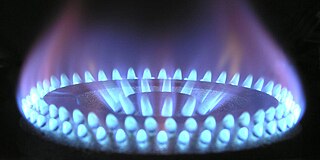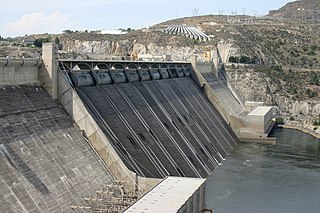Related Research Articles
The British thermal unit (Btu) is a measure of heat, which is a form of energy. It was originally defined as the amount of heat required to raise the temperature of one pound of water by one degree Fahrenheit. It is also part of the United States customary units. The SI unit for energy is the joule (J); one Btu equals about 1,055 J.

Natural gas is a naturally occurring mixture of gaseous hydrocarbons consisting primarily of methane (95%) in addition to various smaller amounts of other higher alkanes. Traces of carbon dioxide, nitrogen, hydrogen sulfide, and helium are also usually present. Methane is colorless and odorless, and the second largest greenhouse gas contributor to global climate change after carbon dioxide. Because natural gas is odorless, odorizers such as mercaptan are commonly added to it for safety so that leaks can be readily detected.

A kilowatt-hour is a non-SI unit of energy equal to 3.6 megajoules (MJ) in SI units which is the energy delivered by one kilowatt of power for one hour. Kilowatt-hours are a common billing unit for electrical energy supplied by electric utilities. Metric prefixes are used for multiples and submultiples of the basic unit, the watt-hour.

Fuel efficiency is a form of thermal efficiency, meaning the ratio of effort to result of a process that converts chemical potential energy contained in a carrier (fuel) into kinetic energy or work. Overall fuel efficiency may vary per device, which in turn may vary per application, and this spectrum of variance is often illustrated as a continuous energy profile. Non-transportation applications, such as industry, benefit from increased fuel efficiency, especially fossil fuel power plants or industries dealing with combustion, such as ammonia production during the Haber process.

Water heating is a heat transfer process that uses an energy source to heat water above its initial temperature. Typical domestic uses of hot water include cooking, cleaning, bathing, and space heating. In industry, hot water and water heated to steam have many uses.
The barrel of oil equivalent (BOE) is a unit of energy based on the approximate energy released by burning one barrel of crude oil. The BOE is used by oil and gas companies in their financial statements as a way of combining oil and natural gas reserves and production into a single measure, although this energy equivalence does not take into account the lower financial value of energy in the form of gas.
The heating value of a substance, usually a fuel or food, is the amount of heat released during the combustion of a specified amount of it.
The following outline is provided as an overview of and topical guide to energy:
In the United States, the efficiency of air conditioners is often rated by the seasonal energy efficiency ratio (SEER) which is defined by the Air Conditioning, Heating, and Refrigeration Institute, a trade association, in its 2008 standard AHRI 210/240, Performance Rating of Unitary Air-Conditioning and Air-Source Heat Pump Equipment. A similar standard is the European seasonal energy efficiency ratio (ESEER).
Gasoline gallon equivalent (GGE) or gasoline-equivalent gallon (GEG) is the amount of an alternative fuel it takes to equal the energy content of one liquid gallon of gasoline. GGE allows consumers to compare the energy content of competing fuels against a commonly known fuel, namely gasoline.
Energy is defined via work, so the SI unit of energy is the same as the unit of work – the joule (J), named in honour of James Prescott Joule and his experiments on the mechanical equivalent of heat. In slightly more fundamental terms, 1 joule is equal to 1 newton metre and, in terms of SI base units

Natural gas prices, as with other commodity prices, are mainly driven by supply and demand fundamentals. However, natural gas prices may also be linked to the price of crude oil and petroleum products, especially in continental Europe. Natural gas prices in the US had historically followed oil prices, but in the recent years, it has decoupled from oil and is now trending somewhat with coal prices.
The energy content of biofuel is the chemical energy contained in a given biofuel, measured per unit mass of that fuel, as specific energy, or per unit of volume of the fuel, as energy density. A biofuel is a fuel produced from recently living organisms. Biofuels include bioethanol, an alcohol made by fermentation—often used as a gasoline additive, and biodiesel, which is usually used as a diesel additive. Specific energy is energy per unit mass, which is used to describe the chemical energy content of a fuel, expressed in SI units as joule per kilogram (J/kg) or equivalent units. Energy density is the amount of chemical energy per unit volume of the fuel, expressed in SI units as joule per litre (J/L) or equivalent units.

Natural-gas processing is a range of industrial processes designed to purify raw natural gas by removing contaminants such as solids, water, carbon dioxide (CO2), hydrogen sulfide (H2S), mercury and higher molecular mass hydrocarbons (condensate) to produce pipeline quality dry natural gas for pipeline distribution and final use. Some of the substances which contaminate natural gas have economic value and are further processed or sold. Hydrocarbons that are liquid at ambient conditions: temperature and pressure (i.e., pentane and heavier) are called natural-gas condensate (sometimes also called natural gasoline or simply condensate).

A packaged terminal air conditioner (PTAC) is a type of self-contained heating and air conditioning system intended to be mounted through a wall. The first practical semi-portable air conditioning unit invented by engineers at Chrysler Motors. It entered the market in 1935, and was designed to fit under a window like many modern PTACs.
The efficiency of a plant is the percentage of the total energy content of a power plant's fuel that is converted into electricity. The remaining energy is usually lost to the environment as heat unless it is used for district heating.
The Glossary of fuel cell terms lists the definitions of many terms used within the fuel cell industry. The terms in this fuel cell glossary may be used by fuel cell industry associations, in education material and fuel cell codes and standards to name but a few.
The United States state of Arkansas is a significant producer of natural gas and a minor producer of petroleum.

Natural gas was the United States' largest source of energy production in 2016, representing 33 percent of all energy produced in the country. Natural gas has been the largest source of electrical generation in the United States since July 2015.
References
- ↑ IEEE Std 260.1-2004
- ↑ Official Journal L 073, P. 0114 27 March 1972
- ↑ 15 USC Chapter 6 Archived 2006-01-25 at the Wayback Machine
- ↑ The Units of Measurement Regulations 1995
- ↑ Jerry Knight (22 January 1978). "Gas Utilities Stepping Up Efforts to Add Customers". The Washington Post. Retrieved 1 June 2016.
- ↑ Wayne C. Turner; Steve Doty (8 October 2013). Energy Management Handbook: 8th Edition. Lulu.com. pp. 337–. ISBN 978-1-304-52087-6.
- ↑ Wayne C. Turner; Steve Doty (2007). Energy Management Handbook. The Fairmont Press, Inc. pp. 567–. ISBN 978-0-88173-543-7.
- ↑ Its (1977). Bulletin. The Univ. p. 300.
- ↑ Proceedings. International Society of Hydrocarbon Measurement. 1982. p. 394.
- ↑ Public Utilities Reports. Lawyers Cooperative Publishing Company. 1986. p. 281.
- ↑ Standard & Poor's (1997). Standard and Poor's Smallcap Six Hundred Guide. McGraw-Hill. ISBN 978-0-07-052503-0.
- ↑ E.W. McAllister (2 June 2015). Pipeline Rules of Thumb Handbook: A Manual of Quick, Accurate Solutions to Everyday Pipeline Engineering Problems. Gulf Professional Publishing. pp. 297–. ISBN 978-0-08-094943-7.
- ↑ Steve Doty (2011). Commercial Energy Auditing Reference Handbook. The Fairmont Press, Inc. pp. 134–. ISBN 978-0-88173-648-9.
- ↑ epa.gov "Greenhouse Gases Equivalencies Calculator - Calculations and References"